Bhopal technological disaster
 Bashny.Net
Bashny.Net
December 2, 1984. The unsuspecting city of a million people in Bhopal, located in the heart of India, went to bed. One of the objects of the industry of the city was an American factory and still successfully existing company «Union Carbide», which were on duty around the clock and working locals. The company at that time was one of the most successful industrial companies in the United States. They produced at this plant popular at the time insecticide "Sevin", which was used in the process of methyl isocyanate (MIC).
MIC - an extremely toxic substance having a boiling point of 38 (9?) ° C and in the decay of the property stand out even more heat, which causes a chain reaction. As a result, released hydrogen cyanide, carbon monoxide and nitrogen oxides.
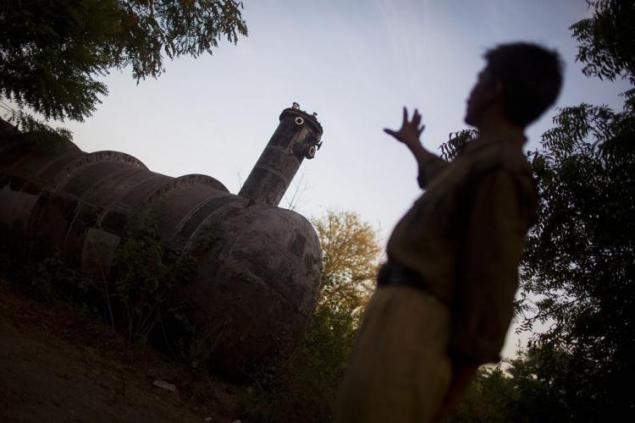
As it happens, even a couple of hours before the accident there were no signs of trouble:
23:00 - attendant noticed on the remote unusual increase in pressure in the tank.
00:15 - in the control room was informed that in the shop somewhere leaking MIC. This has happened before.
00:16 - a sudden jump in pressure in the tank MIC exceeds the maximum permissible level.
00:18 - the pressure increases even twice, the operator runs the shop and sees a concrete base of the tank, in which there were 42 tons of MIC that exactly forty-two times the resolution of international standard norm storage, is destroyed. The decision to include a scrubber, but he was at the time of repair. Run the refrigerator for cooling and MIC nedopuskaniya chain reaction also does not work, he was blocked for a long time to save energy and Freon. Burn gas in the plume also fails. As a result, all the standard tools for removing the accident have been exhausted.
00:20 - duty report a problem boss. Through the already polluted room he gets to the control room, the next 15 minutes are spent on discussion of solutions.
00:35 - attempts to cool the tank with water from the hoses do not help, contaminated rooms begin to die working.
1:00 - kicks pressure relief valve (tank stands), and 42 tons of MIC with impurities phosgene and monomethylamine gradually flock into the atmosphere. Survivors include working siren and leave the plant in the hope of escape.
According to the «Union Carbide», all this is the result of sabotage, which is arranged shortly before the laid-off workers, dropping into the water tank, but not calculating or without considering all the consequences. There is another version, according to which all happened because of the banal negligence workers, prevent the ingress of water into the system.
As the night was cool, concentrated poison cloud during its movement was pressed to the ground, and its height does not exceed five meters. It went towards the slums of Bhopal and the train station, located 2 km from the plant. People woke up at his approach in their homes by attacks of breathlessness and coughing. Many children died in his sleep, while others died later, as due to its growth received higher doses of creeping along the ground gas. In the network still if you wish, you can find them horrible pictures of dead bodies.
The sound of sirens and few could tie happening, from what initially took no bailout. Once, when did the evacuation of people, many died in the current stampede. On the first day of the disaster killed about 3 thousand people. Many of the survivors died after because doctors could not help them - «Union Carbide» initially did not want to clarify the causes of poisoning, hoping to preserve trade secrets.
The results:
• According to various estimates from 18,000 to 20,000 people were killed.
• The number of victims is estimated at 150-600 thousand people.
• $ 470.000.000 was paid to the victims of the tragedy. In terms of people received about $ 1-2 thousand per person.
• In 2004, the art group «The Yes Men» staged hoax in which to «BBC World» announced the sale of «Union Carbide» and distribution of the proceeds of $ 12 billion for disaster relief, medical care and research of possible harm from others the company's products. This caused a serious decline in the company's shares.
• June 7, 2010 the perpetrators of the largest in the history of man-made disaster were sentenced to 2 years in prison and a fine of $ 2,100 (100,000 rupees). All they intend to appeal the verdict.
1. Police indicates the fuel tank, from which in 1984 was leaked contents into the atmosphere, on the site of the former plant «Union Carbide» November 28, 2009 in Bhopal, India. 25 years after the gas leak at the plant «Union Carbide», due to which several thousand people died, toxic substances, "the largest man-made disaster in the world" continue to adversely affect the residents of Bhopal. The new generation is growing weak, the sick. The consequences of the disaster have only recently begun to affect the next generation, appearing visually. (Daniel Berehulak / Getty Images)

2. At the archived images from December 4, 1984, you can see the soldiers guarding the entrance to the plant «Union Carbide» Bhopal leak after deadly poisonous gas. Survivors of the world's largest man-made disaster were shocked to learn that the former factory that killed thousands of people, planned to open to the public 25 years later. These plans never materialized. (BEDI / AFP / Getty Images)
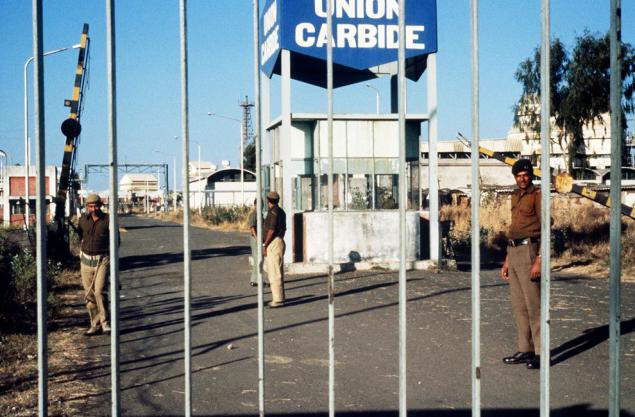
3. In this photo from December 4, 1984 you see people blinded as a result of a gas leak at the plant in Bhopal. (AFP / AFP / Getty Images)
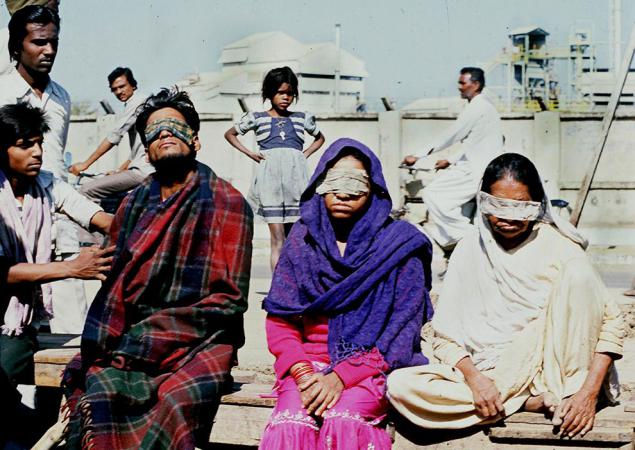
4. The victim lost his sight gas leak at the plant «Union Carbide» Bhopal December 4, 1984. They are waiting on the street until they examined by a doctor. (BEDI / AFP / Getty Images)
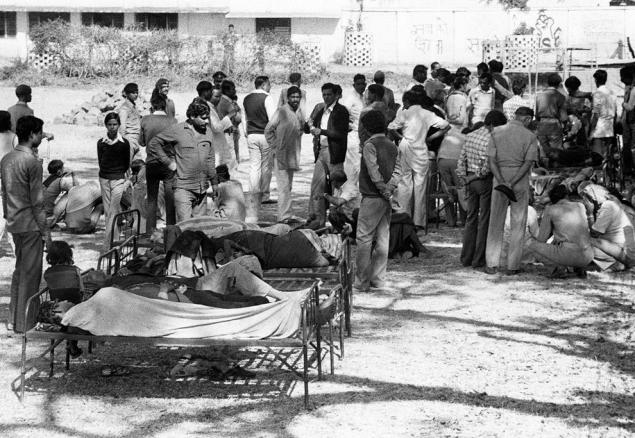
5. mechanisms Abandoned Chemical Plant «Union Carbide» November 21, 2009. (AP Photo / Saurabh Das)
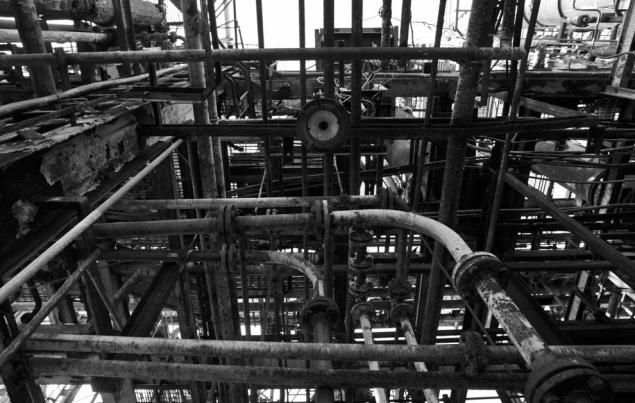
6. gaping hole in a rusty container at a chemical plant «Union Carbide» November 21, 2009. (AP Photo / Saurabh Das)
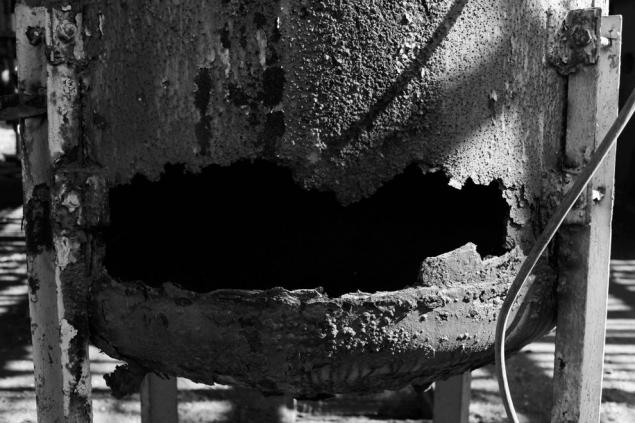
7. Security guy rides a bicycle past the remains of the plant «Union Carbide» in Bhopal, India, November 21, 2009. (AP Photo / Saurabh Das)
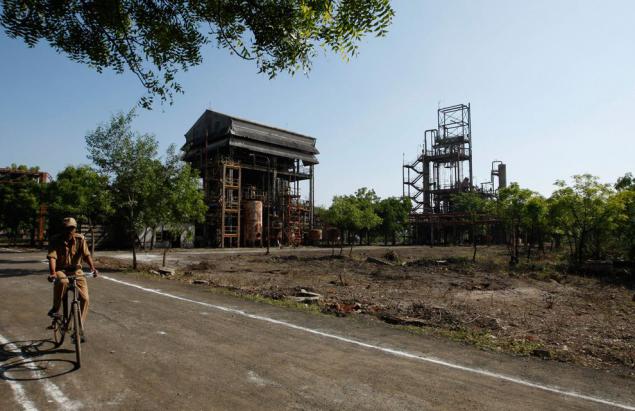
8. Abandoned bottles of chemicals on the floor of a building on the site of a chemical plant desolate «Union Carbide» November 28, 2009 in Bhopal, India. (Daniel Berehulak / Getty Images)
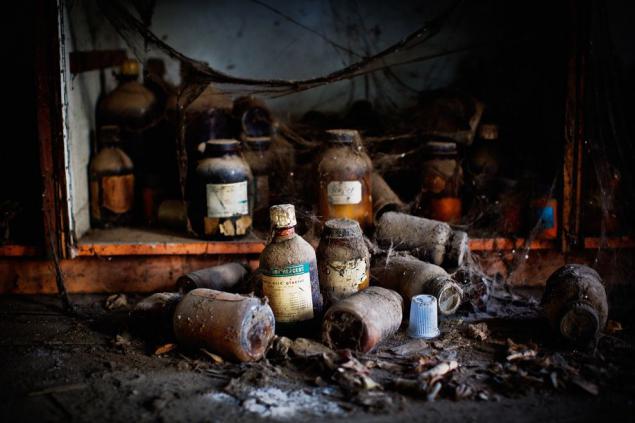
9. In the hole in the wall, you can see the boy, trying to take the calf in the pasture, at the plant «Union Carbide» in Bhopal, India, November 20, 2009. (AP Photo / Saurabh Das)
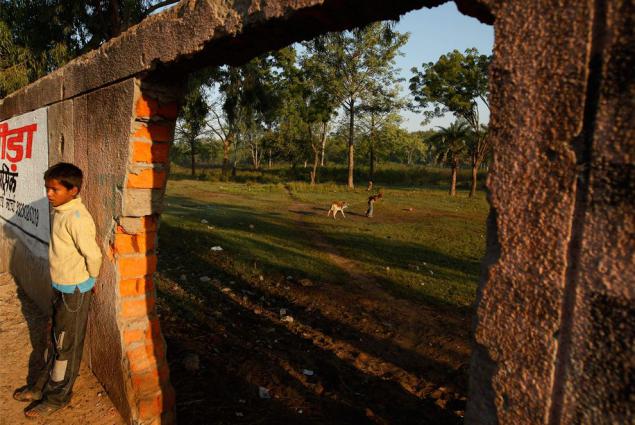
10. Women fill containers with clean water in Bhopal, which brought here, because the local water was contaminated during a gas leak at the plant «Union Carbide» November 28, 2009. (Daniel Berehulak / Getty Images)

11. Activists and survivors of the Bhopal disaster of 1984 held up signs at the office of the company «Dow Chemical» in Noida on the outskirts of New Delhi on Thursday 19 November 2009. A subsidiary of US chemical company «Union Carbide» plant manager during the incident. For decades, the survivors are fighting for the demolition of the plant, but their attempts met with difficulties when the plant «Union Carbide» acquired company «Dow Chemical Co.» in 2001. The company claims that it is not responsible for the demolition of the plant and disaster relief. (Staffing / Manish Swarup)

12. Activists of the group of survivors in Bhopal disaster burn an effigy during a protest against the company «Union Carbide Corp» before the 25th anniversary of the disaster in 1984 in Bhopal November 29, 2009. (REUTERS / Raj Patidar)
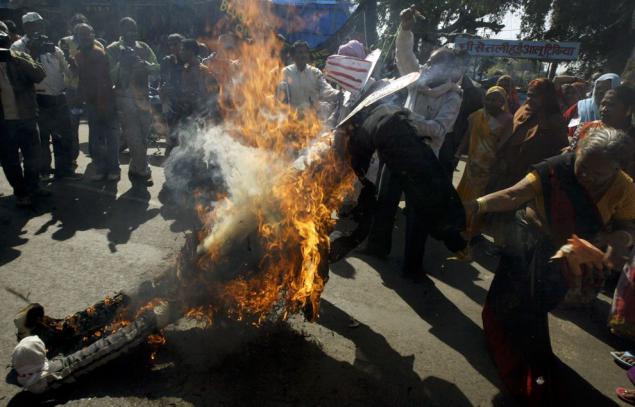
13. Activists and survivors of the Bhopal disaster in 1984, because of which killed and injured thousands of people protesting against the company «Dow Chemical» at her office in Noida on the outskirts of New Delhi on Thursday 19 November, 2009. (Staffing / Manish Swarup)

14. A policeman inspects the abandoned factory «Union Carbide» November 28, 2009 in Bhopal, India. (Daniel Berehulak / Getty Images)

15. People walk past a statue of a mother with a dead child in her arms in Bhopal November 18, 2009. Residents of the city bitterly looking towards the old factory «Union Carbide», where the morning December 3, 1984 there was a gas leak in an instant killed thousands of people. Residents say that every anniversary - another year of physical and psychological trauma complicating negligence on the part of governments and companies. (RAVEENDRAN / AFP / Getty Images)
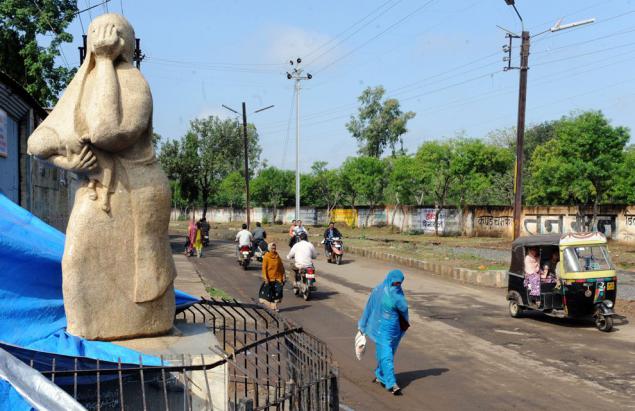
16. Nafisa Bi - coordinator of the clinic «Chingari Trust» - carries a 8-year old Anna November 27, 2009 in Bhopal, India. 25 years after the gas leak that caused the deaths of thousands of innocent people, the consequences of the world's largest man-made disaster continue to harm the residents of Bhopal. Annan has cerebral palsy and is treated in the clinic «Chingari Trust». (Daniel Berehulak / Getty Images)
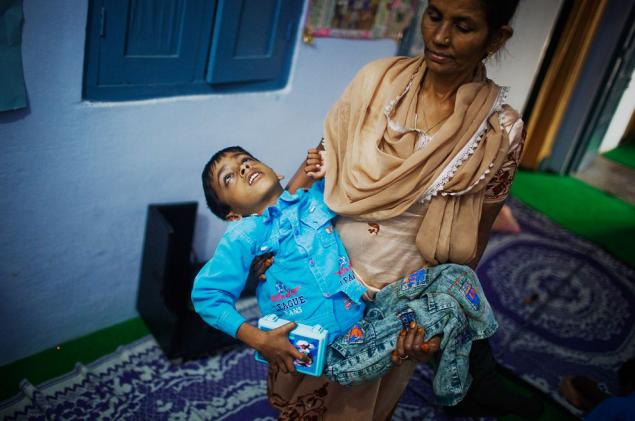
17. mentally retarded 10-year-old Nawab Mian - victim of a catastrophe in 1984 - playing with chicken near the abandoned factory «Union Carbide» November 28, 2009 in Bhopal, India. (Daniel Berehulak / Getty Images)
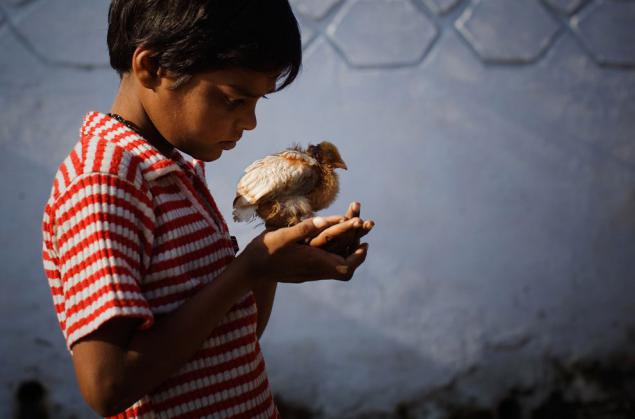
18. Apeksha Mulvey eats at home in Bhopal, India, November 22, 2009. 25 years after the man-made disaster, many mothers have given birth to physically or mentally disabled children. (AP Photo / Saurabh Das)
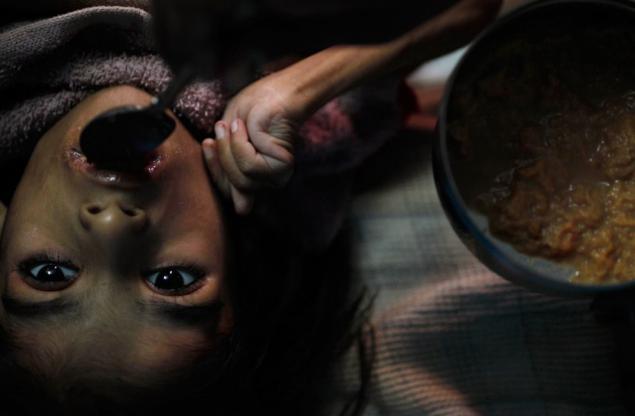
19. Children are carried in contaminated groundwater near the abandoned factory «Union Carbide» November 28, 2009 in Bhopal, India. (Daniel Berehulak / Getty Images)
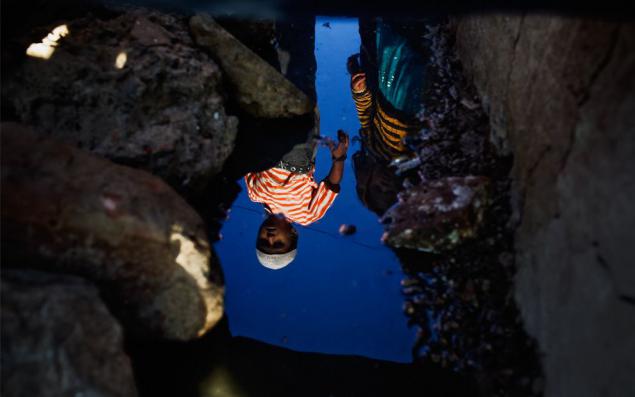
20. In this photo taken on Nov. 21, 2009, a photographer captured the cow. She found one in a government hospital, gave to the victims of a gas leak at the plant in Bhopal, India. (AP Photo / Saurabh Das)

21. People are containers with water collected in the territory of the former factory «Union Carbide» in Bhopal, India, November 21, 2009. (AP Photo / Saurabh Das)

22. Women who complain of ailments related to the disaster in Bhopal gas leak, waiting in line to see a doctor at the clinic NGO in Bhopal, India, November 20, 2009. (AP Photo / Saurabh Das)
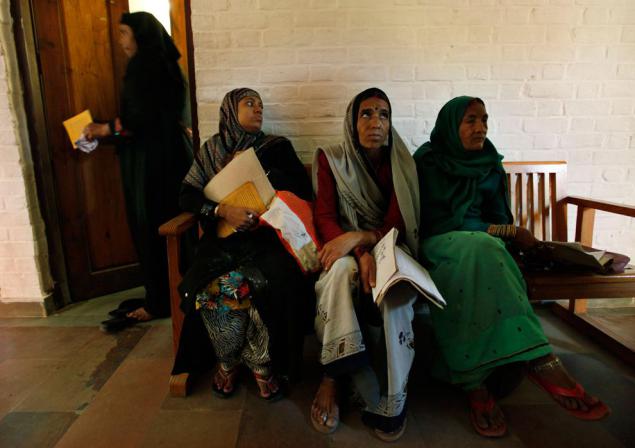
23. Raziq says words during exercise with a speech therapist Prem Patel in rehab «Chingari Trust» November 27, 2009 in Bhopal, India. (Daniel Berehulak / Getty Images)
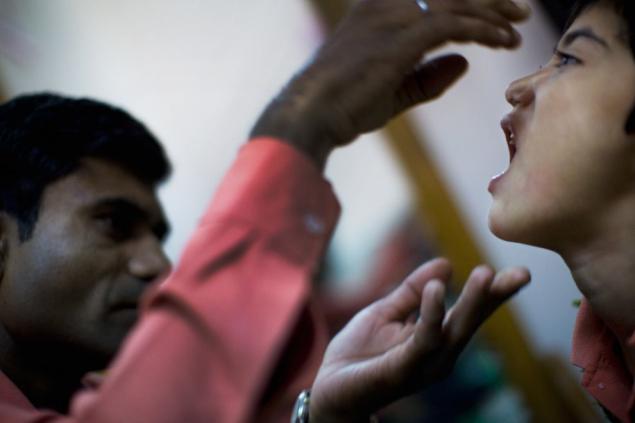
24. Hira Lal, has lost the ability to move and hear, lying on a makeshift bed in his hut in Bhopal, India, on April 7, 2009. (AP Photo / Saurabh Das)
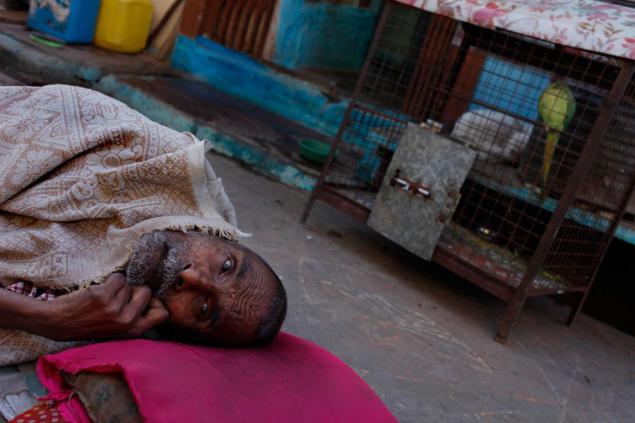
25. Children play at their homes near the plant «Union Carbide» November 27, 2009 in Bhopal, India. (Daniel Berehulak / Getty Images)

26. A man jumps off the perimeter wall at the plant «Union Carbide» November 28, 2009 in Bhopal, India. (Daniel Berehulak / Getty Images)
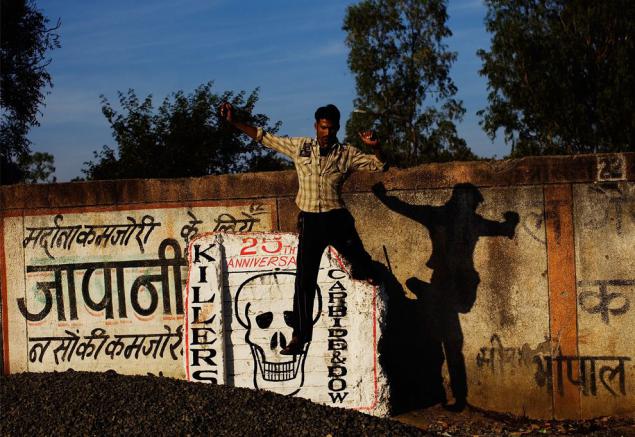
27. Physiotherapist keeps foot 7-year-old child in the hospital non-governmental organization for victims of man-made disaster in Bhopal, India, November 20, 2009. (AP Photo / Saurabh Das)
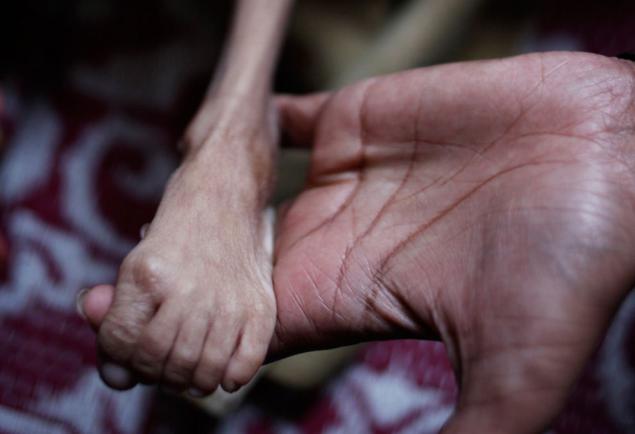
28. A girl stands near the water tower near his home near the plant «Union Carbide» November 27, 2009 in Bhopal, India. (Daniel Berehulak / Getty Images)
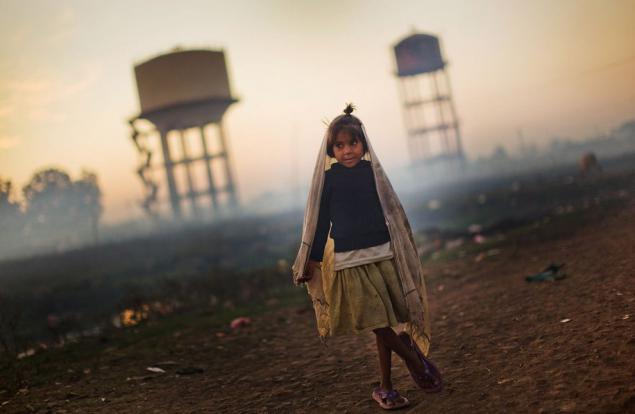
MIC - an extremely toxic substance having a boiling point of 38 (9?) ° C and in the decay of the property stand out even more heat, which causes a chain reaction. As a result, released hydrogen cyanide, carbon monoxide and nitrogen oxides.

As it happens, even a couple of hours before the accident there were no signs of trouble:
23:00 - attendant noticed on the remote unusual increase in pressure in the tank.
00:15 - in the control room was informed that in the shop somewhere leaking MIC. This has happened before.
00:16 - a sudden jump in pressure in the tank MIC exceeds the maximum permissible level.
00:18 - the pressure increases even twice, the operator runs the shop and sees a concrete base of the tank, in which there were 42 tons of MIC that exactly forty-two times the resolution of international standard norm storage, is destroyed. The decision to include a scrubber, but he was at the time of repair. Run the refrigerator for cooling and MIC nedopuskaniya chain reaction also does not work, he was blocked for a long time to save energy and Freon. Burn gas in the plume also fails. As a result, all the standard tools for removing the accident have been exhausted.
00:20 - duty report a problem boss. Through the already polluted room he gets to the control room, the next 15 minutes are spent on discussion of solutions.
00:35 - attempts to cool the tank with water from the hoses do not help, contaminated rooms begin to die working.
1:00 - kicks pressure relief valve (tank stands), and 42 tons of MIC with impurities phosgene and monomethylamine gradually flock into the atmosphere. Survivors include working siren and leave the plant in the hope of escape.
According to the «Union Carbide», all this is the result of sabotage, which is arranged shortly before the laid-off workers, dropping into the water tank, but not calculating or without considering all the consequences. There is another version, according to which all happened because of the banal negligence workers, prevent the ingress of water into the system.
As the night was cool, concentrated poison cloud during its movement was pressed to the ground, and its height does not exceed five meters. It went towards the slums of Bhopal and the train station, located 2 km from the plant. People woke up at his approach in their homes by attacks of breathlessness and coughing. Many children died in his sleep, while others died later, as due to its growth received higher doses of creeping along the ground gas. In the network still if you wish, you can find them horrible pictures of dead bodies.
The sound of sirens and few could tie happening, from what initially took no bailout. Once, when did the evacuation of people, many died in the current stampede. On the first day of the disaster killed about 3 thousand people. Many of the survivors died after because doctors could not help them - «Union Carbide» initially did not want to clarify the causes of poisoning, hoping to preserve trade secrets.
The results:
• According to various estimates from 18,000 to 20,000 people were killed.
• The number of victims is estimated at 150-600 thousand people.
• $ 470.000.000 was paid to the victims of the tragedy. In terms of people received about $ 1-2 thousand per person.
• In 2004, the art group «The Yes Men» staged hoax in which to «BBC World» announced the sale of «Union Carbide» and distribution of the proceeds of $ 12 billion for disaster relief, medical care and research of possible harm from others the company's products. This caused a serious decline in the company's shares.
• June 7, 2010 the perpetrators of the largest in the history of man-made disaster were sentenced to 2 years in prison and a fine of $ 2,100 (100,000 rupees). All they intend to appeal the verdict.
1. Police indicates the fuel tank, from which in 1984 was leaked contents into the atmosphere, on the site of the former plant «Union Carbide» November 28, 2009 in Bhopal, India. 25 years after the gas leak at the plant «Union Carbide», due to which several thousand people died, toxic substances, "the largest man-made disaster in the world" continue to adversely affect the residents of Bhopal. The new generation is growing weak, the sick. The consequences of the disaster have only recently begun to affect the next generation, appearing visually. (Daniel Berehulak / Getty Images)

2. At the archived images from December 4, 1984, you can see the soldiers guarding the entrance to the plant «Union Carbide» Bhopal leak after deadly poisonous gas. Survivors of the world's largest man-made disaster were shocked to learn that the former factory that killed thousands of people, planned to open to the public 25 years later. These plans never materialized. (BEDI / AFP / Getty Images)

3. In this photo from December 4, 1984 you see people blinded as a result of a gas leak at the plant in Bhopal. (AFP / AFP / Getty Images)

4. The victim lost his sight gas leak at the plant «Union Carbide» Bhopal December 4, 1984. They are waiting on the street until they examined by a doctor. (BEDI / AFP / Getty Images)

5. mechanisms Abandoned Chemical Plant «Union Carbide» November 21, 2009. (AP Photo / Saurabh Das)

6. gaping hole in a rusty container at a chemical plant «Union Carbide» November 21, 2009. (AP Photo / Saurabh Das)

7. Security guy rides a bicycle past the remains of the plant «Union Carbide» in Bhopal, India, November 21, 2009. (AP Photo / Saurabh Das)

8. Abandoned bottles of chemicals on the floor of a building on the site of a chemical plant desolate «Union Carbide» November 28, 2009 in Bhopal, India. (Daniel Berehulak / Getty Images)

9. In the hole in the wall, you can see the boy, trying to take the calf in the pasture, at the plant «Union Carbide» in Bhopal, India, November 20, 2009. (AP Photo / Saurabh Das)

10. Women fill containers with clean water in Bhopal, which brought here, because the local water was contaminated during a gas leak at the plant «Union Carbide» November 28, 2009. (Daniel Berehulak / Getty Images)

11. Activists and survivors of the Bhopal disaster of 1984 held up signs at the office of the company «Dow Chemical» in Noida on the outskirts of New Delhi on Thursday 19 November 2009. A subsidiary of US chemical company «Union Carbide» plant manager during the incident. For decades, the survivors are fighting for the demolition of the plant, but their attempts met with difficulties when the plant «Union Carbide» acquired company «Dow Chemical Co.» in 2001. The company claims that it is not responsible for the demolition of the plant and disaster relief. (Staffing / Manish Swarup)

12. Activists of the group of survivors in Bhopal disaster burn an effigy during a protest against the company «Union Carbide Corp» before the 25th anniversary of the disaster in 1984 in Bhopal November 29, 2009. (REUTERS / Raj Patidar)

13. Activists and survivors of the Bhopal disaster in 1984, because of which killed and injured thousands of people protesting against the company «Dow Chemical» at her office in Noida on the outskirts of New Delhi on Thursday 19 November, 2009. (Staffing / Manish Swarup)

14. A policeman inspects the abandoned factory «Union Carbide» November 28, 2009 in Bhopal, India. (Daniel Berehulak / Getty Images)

15. People walk past a statue of a mother with a dead child in her arms in Bhopal November 18, 2009. Residents of the city bitterly looking towards the old factory «Union Carbide», where the morning December 3, 1984 there was a gas leak in an instant killed thousands of people. Residents say that every anniversary - another year of physical and psychological trauma complicating negligence on the part of governments and companies. (RAVEENDRAN / AFP / Getty Images)

16. Nafisa Bi - coordinator of the clinic «Chingari Trust» - carries a 8-year old Anna November 27, 2009 in Bhopal, India. 25 years after the gas leak that caused the deaths of thousands of innocent people, the consequences of the world's largest man-made disaster continue to harm the residents of Bhopal. Annan has cerebral palsy and is treated in the clinic «Chingari Trust». (Daniel Berehulak / Getty Images)

17. mentally retarded 10-year-old Nawab Mian - victim of a catastrophe in 1984 - playing with chicken near the abandoned factory «Union Carbide» November 28, 2009 in Bhopal, India. (Daniel Berehulak / Getty Images)

18. Apeksha Mulvey eats at home in Bhopal, India, November 22, 2009. 25 years after the man-made disaster, many mothers have given birth to physically or mentally disabled children. (AP Photo / Saurabh Das)

19. Children are carried in contaminated groundwater near the abandoned factory «Union Carbide» November 28, 2009 in Bhopal, India. (Daniel Berehulak / Getty Images)

20. In this photo taken on Nov. 21, 2009, a photographer captured the cow. She found one in a government hospital, gave to the victims of a gas leak at the plant in Bhopal, India. (AP Photo / Saurabh Das)

21. People are containers with water collected in the territory of the former factory «Union Carbide» in Bhopal, India, November 21, 2009. (AP Photo / Saurabh Das)

22. Women who complain of ailments related to the disaster in Bhopal gas leak, waiting in line to see a doctor at the clinic NGO in Bhopal, India, November 20, 2009. (AP Photo / Saurabh Das)

23. Raziq says words during exercise with a speech therapist Prem Patel in rehab «Chingari Trust» November 27, 2009 in Bhopal, India. (Daniel Berehulak / Getty Images)

24. Hira Lal, has lost the ability to move and hear, lying on a makeshift bed in his hut in Bhopal, India, on April 7, 2009. (AP Photo / Saurabh Das)

25. Children play at their homes near the plant «Union Carbide» November 27, 2009 in Bhopal, India. (Daniel Berehulak / Getty Images)

26. A man jumps off the perimeter wall at the plant «Union Carbide» November 28, 2009 in Bhopal, India. (Daniel Berehulak / Getty Images)

27. Physiotherapist keeps foot 7-year-old child in the hospital non-governmental organization for victims of man-made disaster in Bhopal, India, November 20, 2009. (AP Photo / Saurabh Das)

28. A girl stands near the water tower near his home near the plant «Union Carbide» November 27, 2009 in Bhopal, India. (Daniel Berehulak / Getty Images)

Tags
See also
Man-made disasters of the XXI century
Waste cities (9 photos + text)
7 tragically abandoned cities of the 20th century (23 pics + text)
7 tragically abandoned cities of the 20th century
Major technological catastrophe in Hungary
Waste cities
Island Hashim (Hashima) - one of the most unique desert islands of Japan.
Man-made disasters
Chernobyl Nuclear Power Plant from a height
On space (17 photos)

















